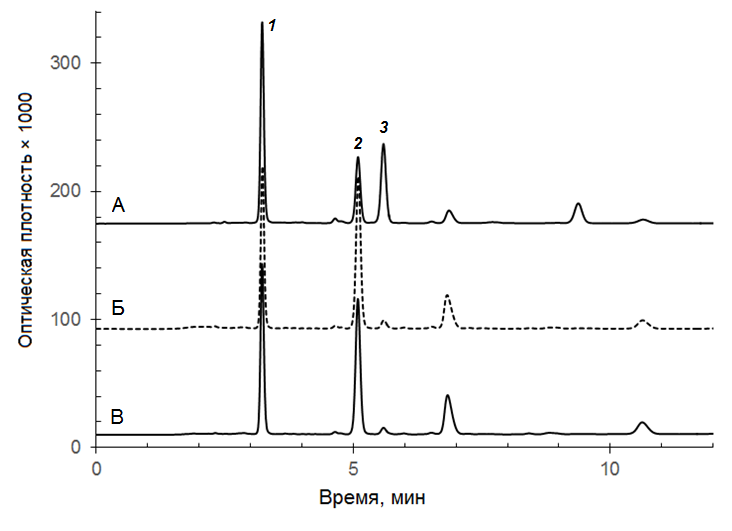DETERMINATION OF ANTHOCYANINS AND CHLOROGENIC ACIDS IN FRUITS OF ARONIA GENUS: THE EX-PERIENCE OF CHEMOSYSTEMETICS
Abstract
The fruits of several species of Aronia genus were studied on the content of anthocyanins and chlorogenic acids. It was found that errors in determining the Aronia species can be excluded by using quantitative ratios between the main anthocyanins – cyanidin-3-galactozide (Cy3Gala, the main component), cyanidin-3-arabinoside (Cy3Ara), cyanidin-3-glucoside (Cy3Glu) and cyanidin-3-xyloside (Cy3Xyl). The highest level of anthocyanin accumulation was found for Aronia melanocarpa (Michx.) Elliott. fruits. Meanwhile for the species differentiation the least accumulation in fruits of Cy3Glu (no more than 0.8% of the total anthocyanins) and Cy3Xyl (not more than 1.5 mole % of the amount of anthocyanins) may explored in comparison with that of A. prunifolia (Marshall) Rehder and A. mitschurinii A. K. Skvortsov & Maitul., the latter being often mistaken for black chokeberry. Even more reliable for the differentiation is the content and ratio of isomeric chlorogenic acids in the fruits. So, fruits of A. melanocarpa accumulate as the main chlorogenic acid 3-caffeoylquinic acid (3CQA, about 69.4 mole % of the sum of chlorogenic acids) and, in smaller but comparable amounts 5-caffeoylquinic (5CQA) and 4-caffeoylquinic (4CQA) acids, which account for about 14 mole %. In fruits of other species of chokeberry accumulation levels of 3CQA and 5CQA are comparable, but may vary with the change of the dominant one, while the accumulation 4CQA is characteristically low (less than 3.5 mole %). The paper discusses and experimentally confirms some errors in the sample preparation of Aronia fruit samples before the qualitative and quantitative determination of anthocyanins, and proposes a method of excluding them.
Downloads
Metrics
References
Safronova I.V., Kozlov V.A., Gol'dina I.A., Gaydul' K.V. Innovatsii i prodovol'stvennaya bezopasnost', 2014, no. 3, pp. 32–43. (in Russ.).
Kuklina A.G. Lesokhozyaystvennaya in-formatsiya, 2015, no. 2, pp. 46–56. (in Russ.).
Brand M.H., Connolly B.A., Lanfang H. Levine L.H., Richards J.T., Shine S.M., Spencer L.E. Scientia Horticulturae, 2017, vol. 224, pp. 332–342, DOI: 10.1016/j.scienta.2017.06.021.
Tsvelev N.N. Flora Vostochnoy Yevropy. [Flora of Eastern Europe]. St. Petersburg, 2001, vol. 10, pp. 555–556. (in Russ.).
Wangensteen H., Bräunlich M., Nikolic V., Malterud K.E., Slimestad R., Barsetta H. J. Funct. Foods, 2014, vol. 7, pp. 746 –752, DOI: 10.1016/j.jff.2014.02.006.
Leonard P.J., Brand M.H., Connolly B.A., Obae S.G. HortScience, 2013, vol. 48, pp. 520–524.
Szopa A., Kokotkiewicz A., Kubica P., Banaszczak P., Wojtanowska-Krośniak A., Krośniak M., Marzec-Wroblewska U., Badura A., Zagrodzki P., Bucinski A., Luczkiewicz M., Ekiert H. Eur. Food Res. Technol., 2017, vol. 243, pp. 1645–1657, DOI: 10.1007/s00217-017-2872-8.
Vinogradova-Maitulina Y., Grygorieva O., Vergun O., Brindza J. Potravinarstvo Slovak J. Food Sci., 2017, vol. 11, pp. 754–760, DOI: 10.5219/845.
Deyneka V.I., Sidorov A.N., Deyneka L.A., Tynyanaya I.I. Sorbtsionnyye i khromatograficheskiye protsessy, 2016, vol. 16, no. 3, pp. 384–389. (in Russ.).
Deyneka L.A., Blinova I.P., Kul'chenko YA.I., Ozer P.S., Sayenko I.I., Deyneka V.I. Uspekhi sovremennogo yestestvoznaniya, 2016, no. 2, pp. 16–20. (in Russ.).
Logvinova Ye.Ye., Brezhneva T.A., Slivkin A.I.,. Samylina I.A, Berest I.S. Vestnik VGU, Ser. Khimiya. Biologiya. Farmatsiya, 2014, no. 1, pp. 122–125. (in Russ.).
Logvinova Ye.Ye., Brezhneva T.A., Slivkin A.I., Perova I.B., Eller K.I. Sorbtsionnyye i khromatograficheskiye protsessy, 2017, vol. 17, no. 1, pp. 117–121. (in Russ.).
Challice J.S. Phytochem., 1973, vol. 12, pp. 1095–1101, DOI: 10.1016/S0031-9422(00)91339-6.
Szopa A., Ekiert H. Plant Growth Regul., 2014, vol. 72, pp. 51–58, DOI: 10.1007/s10725-013-9835-2.
Shan Y., Jin X., Cheng Y., Yan W. Internat. J. Food Prop., 2017, vol. 20, pp. 2028–2040, DOI: 10.1080/10942912.2016.1230746.


This work is licensed under a Creative Commons Attribution 4.0 International License.
The authors, which are published in this journal, agree to the following conditions:
1. Authors retain the copyright to the work and transfer to the journal the right of the first publication along with the work, at the same time licensing it under the terms of the Creative Commons Attribution License, which allows others to distribute this work with the obligatory indication of the authorship of this work and a link to the original publication in this journal .
2. The authors retain the right to enter into separate, additional contractual agreements for the non-exclusive distribution of the version of the work published by this journal (for example, to place it in the university depository or to publish it in a book), with reference to the original publication in this journal.
3. Authors are allowed to post their work on the Internet (for example, in a university repository or on their personal website) before and during the review process of this journal, as this may lead to a productive discussion, as well as more links to this published work.











